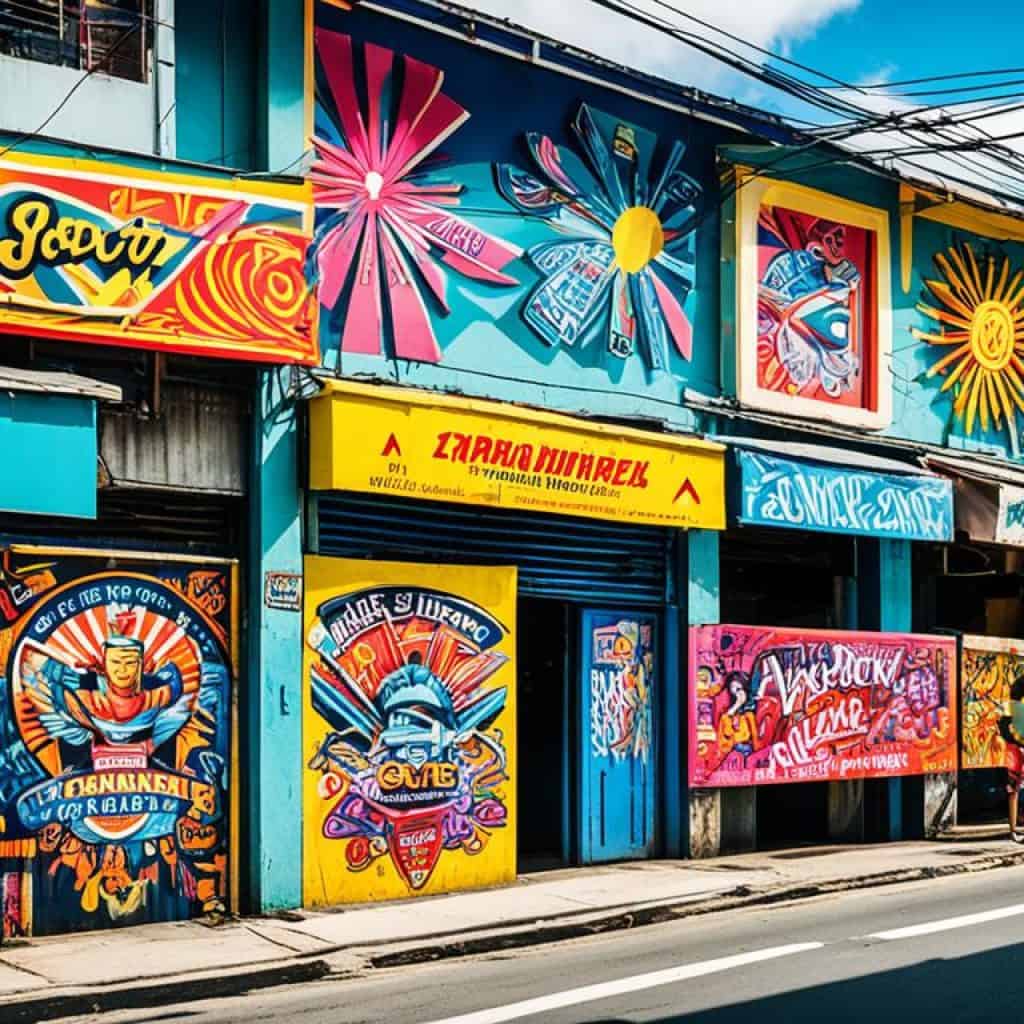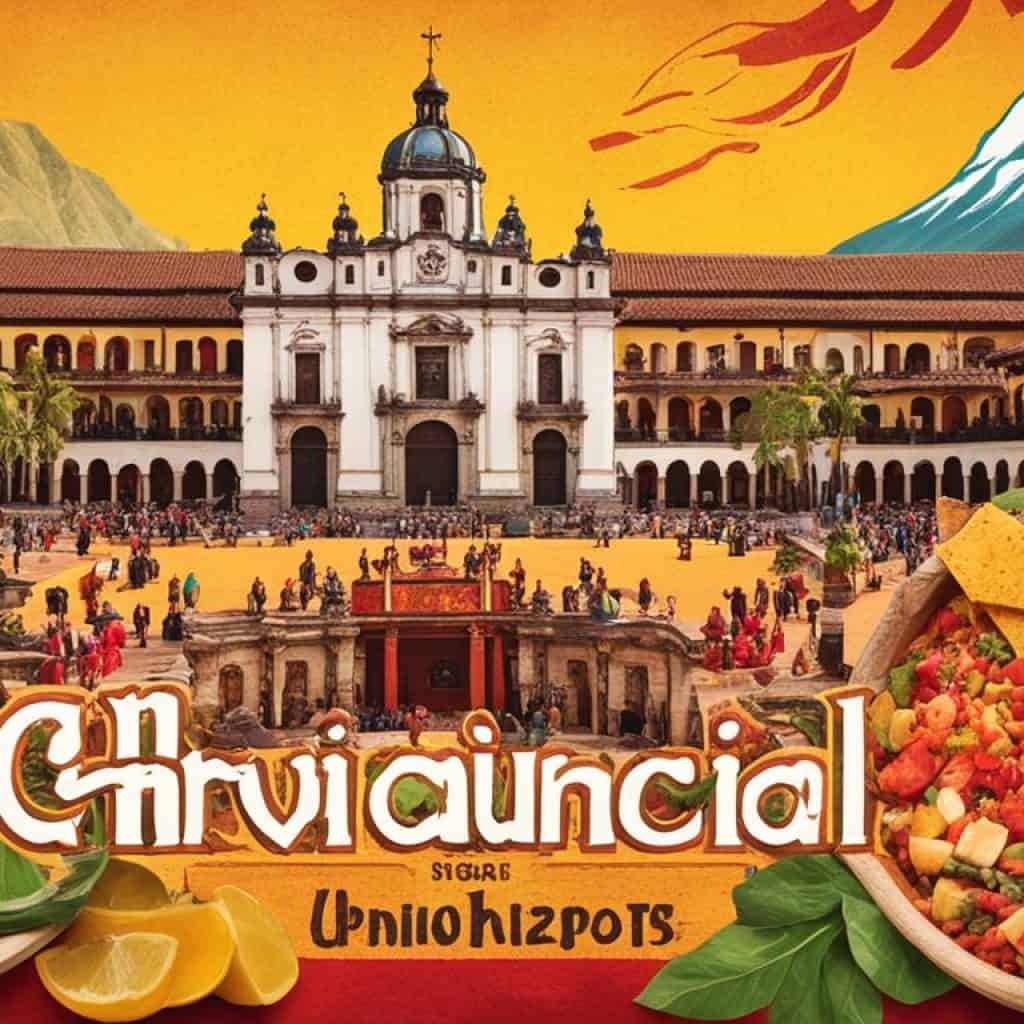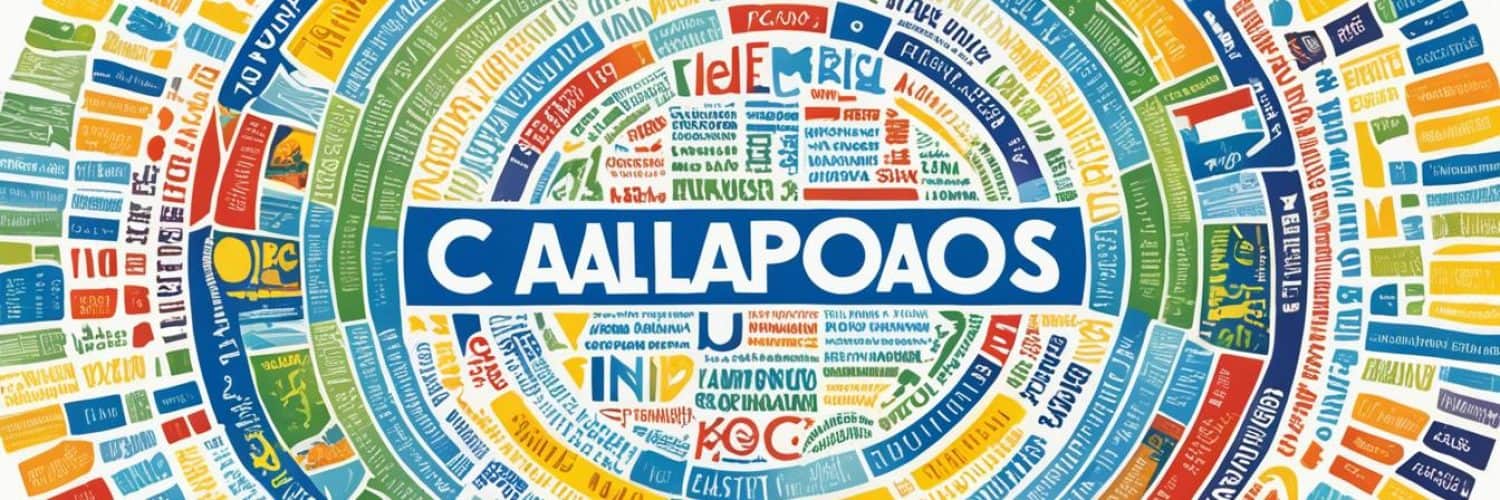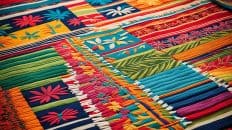Have you ever wondered about the origins of the Philippines’ national language, Tagalog? It has a rich history rooted in Austronesian origins. It also includes Spanish influence and has a significant contemporary role.
Originally called ‘tagá-ilog,’ meaning ‘river dweller,’ Tagalog reflects its people’s early settlement patterns. Tagalog grew by borrowing words from various cultures like China, India, and Arabia. The biggest change came with Spanish colonization, as many Spanish words became part of Tagalog. Today, it symbolizes Filipino identity and unity, appearing in media, literature, and music.
Interested in how Tagalog became the Philippines’ national language? Wondering about Spanish colonization’s impact on it? Curious about Tagalog’s role in modern Filipino culture?
Key Takeaways:
- Tagalog, the national language, originally means ‘river dweller.’
- Tagalog’s roots trace to Austronesian-speaking peoples moving to the Philippines.
- Spanish rule greatly influenced Tagalog with the addition of loanwords.
- In the fight against Spanish control, Tagalog symbolized unity and identity.
- Tagalog laid the foundation for Filipino, embracing the country’s linguistic diversity.
The Austronesian Origins of the Tagalog Language
The Tagalog language belongs to the huge Austronesian language family. It is one of the world’s biggest language groups. The Austronesian people started their journey in Taiwan about 4,000 to 5,000 years ago.
This journey included the ancestors of today’s Tagalog speakers. They moved to the Philippine islands between 2,000 and 3,000 years ago. There, they created communities near rivers and coasts.
The Philippines is home to a lot of languages. This variety comes from Austronesian roots mixed with local culture. Today, this mix has led to many regional languages and dialects.
Key Points:
- The Tagalog language belongs to the Austronesian language family.
- Ancestors of the Tagalog people began their linguistic journey in Taiwan.
- Migration to the Philippine archipelago established Tagalog communities.
- Linguistic diversity within the Philippines stems from Austronesian roots and local influences.
To show the Austronesian roots of Tagalog and how it links to other languages, see the table below:
| Austronesian Languages | Tagalog Dialects |
|---|---|
| Malay | Manila Tagalog |
| Indonesian | Laguna Tagalog |
| Malagasy | Bulacan Tagalog |
| Hawaiian | Bataan Tagalog |
Spanish Colonization and the Influence on Tagalog
Spanish rule had a big impact on the Tagalog language in the Philippines. It lasted over 300 years. This time changed Tagalog’s words, grammar, and even its writing system.
In 1521, Spanish explorers made the Philippines their home. They used Spanish for all official matters. This started the mixing of Spanish words into Tagalog, adding rich new terms reflecting the blend of both cultures.
Many Spanish words found their way into Tagalog. Terms for religion, governance, business, and daily life were included. Words like Tarraha (meaning “work”) and rebulto (meaning “statue”) show how closely the two languages combined.
Tagalog didn’t just borrow words, its grammar changed too. It took on Spanish ways of building sentences, which are still used today.
The Spanish also introduced the Latin alphabet, leaving behind the native Baybayin script. This was a big turn for writing in Tagalog and other local languages. It set the stage for today’s written communication.
The impact of Spanish rule on Tagalog is clear in how the language is structured and spoken today. The blend of Spanish loanwords and grammatical changes shows the deep connections formed between the cultures in the Philippines.
Tagalog and the Fight for Independence
Tagalog, the native language of the Philippines, was crucial in the fight for freedom. It was the key language of the Katipunan, the group leading the revolt. They aimed to free the people from Spanish control.
The Katipunan’s official papers were in Tagalog. This showed the language’s role in spreading ideas and plans. Novels like “Noli Me Tangere” and “El Filibusterismo,” by hero Jose Rizal, were in Tagalog too. They inspired many to join the quest for independence.
“The Katipunan is like a colossal figure, in whose head Tagalog is honored as the official language.”
Tagalog united the freedom fighters. It helped them share their dreams and plans. This created a strong bond among those striving for freedom.
In 1937, Tagalog became the national language. This marked its role in the nation’s freedom and identity. It was a big step for the language, binding the country more closely together.
| Tagalog Independence | Katipunan Revolution | Philippines’ National Language |
|---|---|---|
| Tagalog language played a crucial role in the fight for independence against Spanish colonization. | The secret society Katipunan, whose official documents were written in Tagalog, spearheaded the revolution. | In 1937, Tagalog was declared the national language of the Philippines, symbolizing the country’s independence and unity. |
| Its widespread use facilitated communication and organization among revolutionaries. | Jose Rizal’s novels written in Tagalog, inspired by the national hero, galvanized the revolution. | The declaration ensured the continued significance of Tagalog in the nation’s cultural and linguistic landscape. |
The Emergence of Filipino as a National Language
Tagalog, the indigenous language of the Philippines, laid the groundwork for Filipino. It became the official language in 1959. It was named the national language in the 1987 Constitution. Now, people use Tagalog and Filipino in many situations.
Filipino is crucial for governance, education, media, and daily talk in the Philippines. It brings diversity together, creating a unified identity. Filipinos share their ideas, feelings, and dreams through Filipino.
The emergence of Filipino as the national language shows the Philippines’ dedication to including all languages and cultures. It acts as a bridge, connecting various regional languages. This helps bring Filipinos together under one linguistic banner.
Tagalog’s growth into Filipino celebrates the Philippines’ many cultures, adding words and influences from other local languages. This mix highlights Filipino culture’s richness. It shows how different groups depend on and connect with each other.
By being the national language, Filipino does more than keep Tagalog’s heritage. It also helps recognize and promote other Filipino languages. This action helps save and honor the Philippines’ language variety.
Significance of Filipino as the National Language
Having Filipino as a national language helps build the nation. It makes Filipinos feel united and share goals. It aids in communication, understanding, and cultural sharing within the country.
Seeing Filipino as the national language also helps Filipinos talk to the world. It makes education, government services, and business chances easier to get for Filipinos everywhere.
In short, Filipino’s role as the national language is key to the Philippines’ goals of keeping culture, promoting diversity, and unity.
The Role of Filipino in Education
Filipino is key in the Philippine education system. It is used to teach and builds national identity among students. Learning Filipino lets students understand the culture, values, and traditions of the Philippines better.
The Filipino language helps with literacy and critical thinking. It makes students proud of their heritage. They learn more about their country’s history, literature, and societal issues. This encourages them to be active members of their community and to understand their cultural responsibilities.
| Benefits of Filipino Language Education: | Importance: |
|---|---|
| Preserves cultural heritage | Promotes national identity |
| Enhances communication skills | Improves social cohesion |
| Fosters critical thinking | Empowers active citizenship |
| Enriches understanding of Filipino literature and history | Facilitates appreciation of national arts and culture |
Through learning the Filipino language, students deeply value and understand their cultural and linguistic roots. This ensures the Filipino heritage is kept for the coming generations.
The Importance of Language Translation
Filipinos are making a global impact, raising the demand for Tagalog translation services. These services are key in connecting cultures and fostering understanding. They help highlight Filipino culture worldwide, playing a significant role in cultural exchange and appreciation.
“Translation is not just about converting words from one language to another; it’s about conveying meaning, nuance, and cultural context. It allows people from different backgrounds and languages to connect and understand each other.”
Businesses, individuals, and organizations benefit greatly from Tagalog translation services. They are essential for anyone wanting to communicate effectively with Tagalog speakers or audiences in the Philippines. These services ensure that marketing materials, legal texts, websites, and personal letters are translated professionally. They guarantee both accuracy and cultural awareness.
Language translation also helps preserve the Philippines’ linguistic heritage. It makes possible the translation of literature, historical records, and indigenous languages. This way, they are kept alive for future generations to learn and appreciate.
Benefits of Professional Tagalog Translation Services
1. Accurate and Contextual Translation:
- Professional translators understand Tagalog well, including its subtleties and cultural hints. They ensure that translations maintain the original text’s meaning and purpose.
- Understanding context is critical, especially with idioms, jokes, or specific cultural references. Professionals are experts in customizing content to ensure it appeals to the intended audience.
2. Cultural Sensitivity:
- It’s vital to avoid cultural misunderstandings in communication. Translators know the cultural do’s and don’ts, making translations respectful and suitable.
- They know how crucial it is to use the appropriate tone, formalities, and language level for each translation.
3. Time and Cost Efficiency:
- Having professionals handle translation saves both time and money. This lets individuals and businesses concentrate on their main tasks.
- Relying on machines or inexperienced translators can cause expensive errors. Investing in professional services from the start can prevent this.
4. Global Reach:
- Quality translations can open up international opportunities. They make businesses more accessible and help foster global partnerships.
- Tagalog translation services help reach the Philippine market. They also connect businesses with Tagalog-speaking communities worldwide.
Choosing professional Tagalog translation services is crucial for clear communication. It lets people and organizations bridge language gaps. This way, they create lasting and meaningful connections across the globe.
| Benefits of Professional Tagalog Translation Services | Benefits of Professional Tagalog Translation Services |
|---|---|
| Accurate and Contextual Translation | Cultural Sensitivity |
| Professional translators have a deep understanding of the Tagalog language, its nuances, and cultural references. | Professional translators are well-versed in cultural norms and sensitivities, ensuring that translations are respectful and appropriate for the target audience. |
| They ensure accurate translations that preserve the original meaning and intent of the source text. | They understand the importance of using the right tone, addressing formalities, and employing appropriate language registers when translating content. |
| Context is crucial in language translation, especially when dealing with idioms, jokes, or culturally specific expressions. |
The Genesis of Tagalog
Tagalog comes from ‘tagá-ilog,’ which means ‘river dweller.’ This shows how the Tagalog people first lived by rivers. Over time, the language grew, taking words from different cultures. This shows the Philippines’ rich history and its interactions with China, India, Arabia, and the West.
The name ‘Tagalog’ comes from ‘tagá-ilog,’ showing their river connections. They lived by riverbanks. There, they built communities and developed their special language.
As Tagalog speakers met people from elsewhere, their language changed. It borrowed from Chinese, Indian, Arabic, and Western languages. This makes the vocabulary a record of the Philippines’ past connections.
Early meetings with outsiders shaped Tagalog. It gathered words from China, India, Arabia, and the West. This shows how the Philippines was a place of cultural mixing.
Tagalog’s different words tell us about the Philippines’ past. The mix of foreign words in Tagalog shows the country’s wide connections. It also shows the Filipino spirit.
Tagalog’s start as a language of those living by rivers shows their bond with nature. Now, Tagalog is a key language in the Philippines. It shows the country’s history and contemporary culture.
Foreign Influences on Tagalog
The Philippines is at the heart of trade and cultural exchanges. This has shaped the Tagalog language. Over time, influences from China, India, Arabia, and the West have mixed into the Tagalog vocabulary. This mix shows the diverse heritage of the country.
Spanish language influence is significant due to the Spanish colonizers. Words like “silya” (chair), “tsaa” (tea), and “syempre” (of course) are now part of Tagalog. These words show the blend of cultures in the language.
“Tagalog adopted words like ‘silya,’ ‘tsaa,’ and ‘syempre’ from Spanish, Chinese, and English respectively, reflecting the cultural and linguistic blend present in Tagalog vocabulary.”
Chinese traders and immigrants left their mark too. Words like “tindahan” (store) and “hopiang baboy” (pork pastry) came from Chinese. This highlights Chinese culture’s influence on Tagalog.
English words have also entered Tagalog, thanks to American colonization and globalization. Terms such as “internet,” “computer,” and “soccer” are now commonly used. This shows Tagalog’s ability to adapt and embrace modern terms.
The mix of languages in Tagalog shows the Philippines’ rich history and openness to foreign influences. It highlights the Filipino people’s resilience and adaptability. They continue to evolve their language with global trends and interactions.
Tagalog in Contemporary Culture
Tagalog is a vital part of Filipino culture today. It shows up in media, literature, and music. It shares the unique stories and lives of the Filipino people.
In media, Tagalog stars in TV, movies, and radio. It lets people feel connected to stories and characters they care about. Viewers enjoy everything from family dramas to action-packed shows.
Tagalog also touches the literary world. You’ll find it in books, magazines, and newspapers. Writers and poets use it to share their take on life, love, and society.
“Tagalog literature has a unique ability to transport readers, evoking emotions and provoking introspection. It reflects the complexities of Filipino society and offers a platform for critical discourse,” says acclaimed Filipino author, Mia Santos.
Moreover, Tagalog music fills the air both in and out of the Philippines. There are traditional tunes and modern hits. This music highlights Filipino culture and creativity.
“Music in Tagalog allows me to express my deepest emotions and connect with others. It’s a universal language that speaks to the soul,” says award-winning singer-songwriter, Miguel Rivera.
In today’s culture, Tagalog helps discuss important issues. Artists use it to talk about inequality, unrest, and culture. This starts conversations and builds a deeper understanding of Filipino identity.

Tagalog is everywhere, from radios to libraries. It’s the heart of the Filipino people. It shapes and enhances Filipino culture in many ways.
The Austronesian Expansion and the Arrival in the Philippine Archipelago
The Austronesian language family, including Tagalog, began in Taiwan. It spread through sea travel. About 2,000 to 3,000 years ago, Austronesian speakers reached the Philippine archipelago. They set up homes by rivers and the sea.
These newcomers met various native groups. This led to the rich language variety in the Philippines now.
As Austronesian people moved south, they shared their language and customs. This sharing is why Austronesian languages, like Tagalog, have much in common.
The Austronesian Expansion Timeline:
| Time Period | Key Events |
|---|---|
| 4000-5000 years ago | Austronesian journey begins in Taiwan |
| 2000-3000 years ago | Austronesian settlers arrive in the Philippine archipelago |
Immigrants built homes by rivers and seas in the islands. They met and mixed with the various native people of the Philippines. This mix led to today’s linguistic diversity.
It was during this time that Tagalog grew. It took in influences from the indigenous languages and cultures of the Philippines.
This picture shows the vast Philippine archipelago with over 7,000 islands. The arrival of Austronesian speakers started the exchange of languages and cultures. This shaped the Philippines.
The Importance of Preserving Regional Languages
Tagalog might be the national language of the Philippines. However, it’s vital to value the diverse regional languages spoken throughout the archipelago. The country’s Constitution highlights the significance of these languages and dialects. They form an essential part of the nation’s cultural identity. Steps are being taken to help preserve these languages.
Languages are the vehicles of culture, history, and unique identities. Keeping regional languages alive is key to preserving the cultural heritage of the Philippines. Each of these languages offers a unique way of seeing the world. They enrich the cultural fabric of Philippine society with their distinct expressions and communication styles.
By protecting regional languages, we help future generations connect with their heritage. They’ll be able to understand their ancestors’ traditions and maintain a strong sense of belonging. These languages offer deep insights into local customs, folklore, and indigenous knowledge. They play a critical role in keeping the Philippines culturally vibrant and diverse.
“Language is the roadmap of a culture. It tells you where its people come from and where they are going.” – Rita Mae Brown
The variety of languages in the Philippines reflects the country’s rich history. It serves as an asset for cultural exchange, artistic expression, and innovation. Each language adds to the collective Filipino experience with its unique idioms and subtleties.
Initiatives to save regional languages include documentations, educational materials, and revitalization programs. Communities, schools, and government bodies work together. Their goal is to give these languages the support and recognition they deserve.
Preserving regional languages is about more than just the languages themselves. It’s about keeping alive the stories, traditions, and identities they represent. It means celebrating linguistic diversity. And recognizing the importance of every language in the Filipino cultural mosaic.
The Benefits of Preserving Regional Languages:
- Preservation of cultural heritage and identity
- Enhanced intergenerational communication and bonding
- Expanded appreciation for the diversity of Philippine languages
- Increased cultural exchange and understanding
- Strengthened community pride and resilience
In our globalized world, connecting to our cultural roots is crucial. Preserving regional languages is a shared responsibility. It ensures the linguistic beauty and richness of the Philippines continues to thrive for future generations.
| Regional Language | Geographic Location | Number of Speakers |
|---|---|---|
| Visayan | Visayas and parts of Mindanao | Approximately 33 million |
| Ilocano | Ilocos Region, parts of Cordillera Administrative Region | Approximately 8 million |
| Bicolano | Bicol Region | Approximately 4 million |
| Hiligaynon | Western Visayas, parts of Mindanao and Negros Occidental | Approximately 9 million |
“Language is the road map of a culture. It tells you where its people come from and where they are going.” – Rita Mae Brown
Baybayin – The Ancient Script of the Tagalog People
The Tagalog people had a sophisticated writing system called Baybayin before the Spanish arrived. It featured characters that stood for syllabic sounds. These sounds were special to the Tagalog language. This script was important for documenting events, preserving culture, and showing artistic skills. It helped tell the stories and beliefs of the Tagalog people.
Baybayin used characters for syllables, making writing clear and brief. It was used for keeping track of history, literature, and personal letters. The Tagalog people saw it as key for keeping their language and culture alive. It made sure their traditions and history were shared with future generations.
However, when the Spanish colonizers came, they brought the Latin alphabet with them. The Latin alphabet slowly took over as the main way to write. This change led the Tagalog people to use the Latin alphabet for writing. Because of this, Baybayin started to be used less and became unfamiliar to many.
Despite Baybayin becoming less common, there are now efforts to bring it back. People and groups are studying and sharing Baybayin to help connect the Tagalog people with their past. Today, more and more people want to learn Baybayin. They see it as a way to understand and honor the Tagalog people’s heritage.
Chavacano – a Mix of Spanish and Tagalog
Chavacano is a unique creole language that blends Spanish with local languages in the Philippines. It started in Cavite, showing the country’s mixed heritage. It uses words, grammar, and structure from both Spanish and Tagalog. As Chavacano spread, it developed different versions, each with unique features.

Exploring Chavacano Variants
Chavacano has different versions across areas, each unique. Some known Chavacano types include:
| Chavacano Variant | Region |
|---|---|
| Chavacano de Zamboanga | Zamboanga City and nearby areas |
| Chavacano de Ternateño | Ternate, Cavite |
| Chavacano de Cavite | Cavite City and neighboring towns |
| Chavacano de Davao | Davao City and surrounding regions |
Every Chavacano variant reflects the local cultures and languages it met. This adds to Chavacano’s richness and complexity.
Chavacano’s mix of Spanish and Tagalog highlights the Philippines’ cultural fusion, showing its history of diverse influences.
Chavacano is key to local identity where it’s spoken. It links Spanish and Tagalog, bridging past and present. It symbolizes the Filipino people’s diverse heritage.
The Linguistic Makeup of the Modern Philippines
The Philippines is home to over 170 languages. This shows the rich culture and history of the area. The national language is Filipino, which comes from Tagalog, but English is also very important.
There are several major native languages besides Tagalog and Filipino. These languages are:
- Cebuano: This is used mainly in the central and southern parts of the country and has a unique way of speaking.
- Ilocano: Most people speak this in the northern Luzon area, and it has its own set of sounds and sentence structures.
- Hiligaynon: This language is spoken in the Western Visayas. It has ties to the Visayan region and has similarities with other Visayan languages.
This variety of languages comes from the Philippines’ history of colonization and trade. This history brought many different cultures together. Over time, this has made the Filipino languages what they are today, each with its own features.
The country is working to bring its languages together and to keep its cultural history alive. The Constitution emphasizes the importance of regional languages in Filipino culture. There are many groups working to keep these languages used and appreciated.
The Preservation of Linguistic Heritage
The Philippines is rich in languages, with many spoken across its islands. Keeping these languages alive is key to holding onto cultural identity. Efforts are made to empower speakers, document languages, and celebrate them nationwide.
Groups focused on language preservation work hard to protect the Philippines’ linguistic heritage. They engage in activities like:
1. Documentation and Archiving
Documenting and keeping a record of indigenous languages is essential. Organizations work with natives and linguists. They record stories, words, and traditions. This saves important language data for the future.
2. Language Revitalization Programs
These programs help native speakers keep their languages alive. Activities include language classes and cultural events. They build community and pride in linguistic heritage, sparking vitality in Filipino languages.
3. Collaboration with Indigenous Communities
Working with indigenous groups is crucial for language preservation. Organizations create initiatives that cater to the specific needs of these communities. This approach helps in maintaining their languages and cultures.
4. Digital Tools and Technology
Digital tools and technology are key for preserving languages. Apps, online platforms, and software make language resources accessible. They aid in learning, practicing, and passing languages down through generations.
“The preservation of linguistic heritage is essential in maintaining the rich cultural tapestry of the Philippines. It ensures that future generations can connect with their roots and fosters a sense of cultural pride and identity.”
Preserving Filipino languages shows a commitment to cultural diversity and inclusiveness. By safeguarding its linguistic heritage, the Philippines works towards a society that values all languages.
Preservation efforts strengthen community ties, empower indigenous people, and link generations. Recognizing and celebrating linguistic diversity will shape a harmonious, culturally rich future.
Conclusion
The journey of Tagalog, from its roots to the national language of the Philippines, shows the resilience of the Filipino people. Tagalog’s rich history includes indigenous roots, Spanish rule, and cultural exchanges. This history mirrors the Philippines’ diverse and vibrant culture.
Over time, Tagalog has grown, absorbing different influences to become a unique language. It showcases the Philippines’ multicultural identity. Today, Tagalog is a key symbol of unity and pride. It brings the Filipino people together, helping them share their thoughts and dreams.
Tagalog plays a big role in the Philippines’ culture, affecting its identity, literature, media, and music. As the Philippines honors its many languages and protects its language heritage, Tagalog stands tall. It is not just about language changes, but also about the Filipino people’s resilience and strength.
FAQ
What is the history of the Tagalog language in the Philippines?
What is the significance of Tagalog in Filipino culture?
How did Spanish colonization influence Tagalog?
What role did Tagalog play in the fight for Philippine independence?
How did Tagalog become the national language of the Philippines?
Why is language translation important in the Philippines?
What influences shaped the Tagalog language?
How is Tagalog used in contemporary Filipino culture?
What is the linguistic diversity in the Philippines?
What efforts are being made to preserve regional languages in the Philippines?
What is Baybayin, and how does it relate to Tagalog?
What is Chavacano and how does it relate to Tagalog?
How is the linguistic heritage of the Philippines being preserved?
What is the significance of Tagalog in the history of the Philippines?
Source Links
- https://www.polilingua.com/blog/post/tagalog-language-origin-evolution-philippine-language.htm
- https://thewordpoint.com/blog/philippines-language-history-exploring-cultural-and-linguistic-heritage
- https://www.worldtranslationcenter.com/blog-posts/how-the-tagalog-language-reflects-the-rich-history-and-diversity-of-the-philippines







Add comment